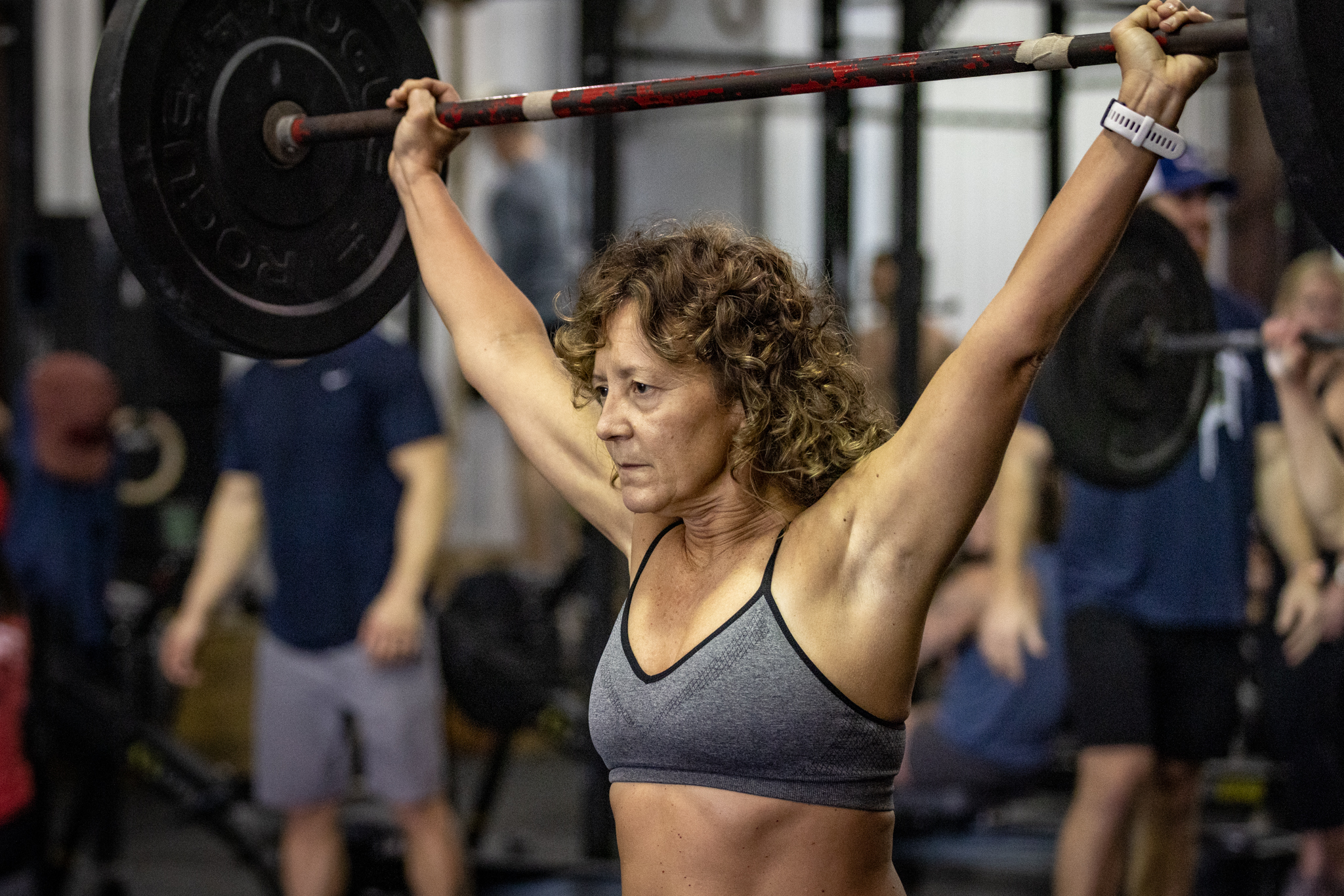In February 2024, CrossFit affiliate owners, coaches, and healthcare professionals came together for the CrossFit for Health Summit, presented by GORUCK. CrossFit thought leaders led panel discussions on fitness, performance, and the hard work of health, while renowned experts shared cutting-edge research on longevity, chronic disease, mental health, and community — and CrossFit’s powerful role in it all.
The sun had set and night had fallen, only streetlights lighting the way for Nancy as she set out to walk her dog.
The 70-something looped the leash around her wrist, freeing both hands to push the walker before her. But a few steps later, she stumbled, falling to the ground alone in the dark.
Falls are the second-leading cause of death by unintentional injury worldwide, with adults over 60 suffering the most falls. In the United States, 36 million falls are reported by older adults each year — 32,000 of which are fatal.
Thankfully, Nancy had spent the last three months doing CrossFit.
She pulled her walker down to the ground beside her, tipping it on its side. From there, she hauled herself upright, leaning on the walker for support, and walked back home. It’s not implausible that Nancy saved her own life with her fitness — which is exactly why her coach, Theresa Sbarra, got into the business of getting seniors into the CrossFit gym.
Sbarra recalled hearing CrossFit founder Greg Glassman speak during a CrossFit Level 1 Certificate Course for medical doctors.
“‘Our seniors are lonely, and they can’t get off the floor,’” she quoted. “And I literally started crying as he was talking, because … I understood it.”
In 2004, Sbarra’s mother developed cryptogenic organizing pneumonia after suffering a bad staph infection.
“I found her in the fetal position in the kitchen, not able to breathe,” Sbarra recalled.
By 2010, Sbarra’s mother kept mostly to her wheelchair, at one time unable to get out of bed for 10 days.
Sbarra, who started CrossFit in 2010 at 46 and became a CrossFit Level 1 Trainer soon after, used her newfound knowledge to help her mother preserve what little mobility she had. She died in 2019.
“There were many, many times that doctors would just prescribe another medicine because they didn’t know what was wrong,” Sbarra recalled. “Western medicine kept her alive long enough to kill her in 10 days on hospice.”
It’s one of the reasons the now-59-year-old traveled to Austin, Texas, to volunteer at the CrossFit for Health Summit in February.
“(Events) like the Health Summit provide so much value,” she said. “The more I learn, the more I can pass on to my clients.”

Theresa Sbarra during the CrossFit for Health Summit workout at CrossFit Central Downtown I Photo by Tyson Oldroyd
And we’re talking life-changing lessons.
In her talk, Summit speaker Dr. Rhonda Patrick — renowned biomedical scientist and researcher specializing in aging, cancer, and nutrition — shared an effect of high-intensity exercise she described as “astounding.”
“As we age, our heart undergoes structural changes,” Patrick began. “It gets smaller in size and it gets stiffer.”
These changes — especially in sedentary individuals — increase the risk of heart disease.
But as a 2018 study by cardiologists at UT Southwestern and Texas Health Resource revealed, such changes are not only not inevitable, but they’re also reversible.
Over the course of the two-year study, sedentary 50-somethings were divided into two exercise intervention groups: one that just did light stretching and yoga and another that followed a high-intensity exercise program, in addition to the stretching.
“And after those two years, the structural changes in their heart reverted back almost 20 years,” Patrick said. “Their hearts got more malleable … and it was like looking at a 30-year-old heart.”
And it’s not just the heart whose decline can be thwarted. Age-related cognitive decline is also “largely preventable,” said Dr. Tommy Wood, an assistant professor at the University of Washington specializing in neuroscience and brain health.
The brain, he said, is just like muscle in its requirements for optimal functioning: it needs proper nutrition and rest, but it also needs to do work.
“If you don’t lift weights, then you don’t get jacked,” he says. “With the brain, and most tissues in the body, their structure and function is directly proportional to the demand that you place on them.”
CrossFit, Wood said — with its unique combination of varied physical and mental demands in a social environment — is a boon for fighting age-related cognitive decline.
“Is it that our function declines over time? Or is it that we just use our brains less over time and then function follows?” he asked. “And … can we change this trajectory with something like CrossFit? I think we can.”
It’s what Sbarra — now a Level 3 CrossFit Trainer — is committed to doing.
“I want to help these people enjoy life and just give them confidence,” she said.
Sbarra started with two senior athletes in June 2023. Today, she has about 17 regulars in the Legends class at CrossFit 585, an affiliate in upstate New York. The oldest, Judy, is 91.
Sbarra’s approach to training is simple.
“I just talk to people about what they need to do,” she said.
Jim, for example, wanted to walk without his walker. So, they worked on sit-to-stands. Then, they practiced stepping over a low band stretched between two posts of a rig. After two months of CrossFit, Jim walked unassisted through an agility ladder — stepping into each square one foot at a time.
Simply, it’s training for life.
“Elderly people live daily in 1-rep-max living,” Sbarra said. “So, when you think of how hard it is for you to do your 1-rep-max deadlift, that’s what it takes for them to get off the floor, off the toilet, into the car.”
CrossFit, she continued, makes those activities of daily living not only possible for seniors, but also safe.
“We have to load them,” she said. “Properly and safely to their abilities.”
Jim isn’t the only one achieving goals long thought impossible. Sharon got down on the floor and back up for the first time in a year. Ruth straightened her back.
“I did something that I never thought I could do,” Ruth said in a video Sbarra took afterward. “And it’s just so joyful, and it gives you a lot more hope.”
Of course, no amount of fitness can prevent 100% of age-related physical decline. But it can make the difference between independence, mobility, survivability — joy — and their counterparts.
“It’s ‘decline,’ not ‘fall,’” Sbarra said. “Not ‘incapacitated.’”
About the Author
Brittney Saline is Senior Writer and Editor for CrossFit, LLC. Previously, she was a writer and editor for the CrossFit Journal. She’s been sharing powerful stories from and for the CrossFit community since 2012, covering topics ranging from problems with healthcare and Big Pharma to CrossFit’s potential for reversing symptoms of Parkinson’s disease to discourses on femininity and musculature. She lives in Minneapolis, Minnesota, with her pug, Leo. Got a story to share? Email Brittney here.

Chronicles From the CrossFit for Health Summit: Defying Decrepitude